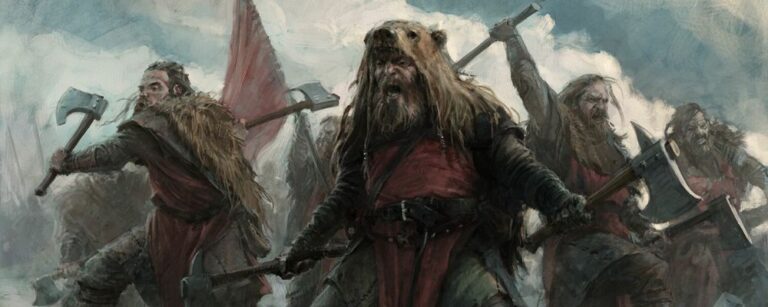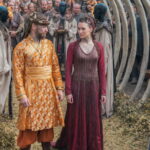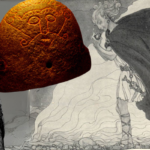The term Vikings is often used as a generic term to refer to a wide and varied group of people, and it is not always clear who exactly those people are. We are very guilty of doing this!
So today, let’s take a closer look at who exactly we are referring to when we use the term Vikings and the different groups that exist underneath that umbrella term. What do the different groups have in common, and what separates them?

Who Are The Vikings?
We use the term Vikings to refer to peoples descended from Germanic tribes, encountered by the Romans in Germany as early as the 1st century AD, who by the 7th century had established themselves in parts of Scandinavia, specifically Norway, Sweden, and Denmark.
While the Vikings were not a single uniform group, they had many things in common. Specifically, they spoke versions of Old Norse and wrote using runes based on earlier Proto-Germanic language. They also followed a similar religion, today known as the Norse religion, which centers on the gods Odin, Thor, and Freyja. They are also consistently seafaring people.
Notably, the Finns aren’t considered Vikings, even though they would have interacted with their Viking neighbors and there was no doubt significant intermarrying and cultural exchange between the Finns and the Vikings. This is because the Finns migrated into the area from the east, rather than Germany, they don’t speak a version of Old Norse, and they have different religious traditions.

Different Types of Vikings
While it is always very difficult to draw clean lines between neighboring peoples, the Vikings can generally be divided into three groups: the Danes, the Norwegians, and the Swedes.
But even these three groups aren’t uniform. They were smaller clan-based societies, but obviously, clans had a lot in common with their neighbors, and they would fight, form alliances, marry, and so forth. The ideas of the Danish, Norwegian, and Swedish nations only emerged in around the 10th century when powerful kings such as Harald Bluetooth managed to bring other leaders under their control.
Also, Viking leaders did not limit themselves by arbitrary borders. The legendary Ragnar Lothbrok was apparently king of both Denmark and Sweden. The empire of the Danish king Cnut the Great covered Denmark, Sweden, and England.
Nevertheless, it is still useful to talk about the Vikings in terms of these three groups.
Danish Vikings

The Danes are the most famous Vikings because they happen to be the ones that we know the most about. This is probably because they were the most politically organized and present in European politics. And since the Vikings have not left any of their own contemporary histories, we have to rely on references to them in the records of others.
The Danes raided to the west, specifically France and England, and set up settlements in those areas. They settled northern France and pretty much took control of Normandy. This is why the Norman Willian the Conqueror is often called a Viking.
They also established themselves across England, but especially around York and Northumbria. Their presence was so strong there that large swathes of the country were governed not by English law, but by Danelaw.
Their close relations with European Christians is probably why the Danish Vikings were the first to convert to Christianity.
The most famous Danish Vikings are the legendary Ragnar Lothbrok and his sons including Bjorn Ironside and Ivar the Boneless. While they were also kings in Sweden, they are of Danish origin. Other famous Danes include King Gorm, considered to have united Denmark as a single nation in the 10th century, his son Harald Bluetooth who led the conversion to Christianity, Sweyn Forkbeard, who was king of England for a short period, and his son Cnut the Great, who ruled over an empire that included Denmark, Sweden, and England.
You can read our full article on the Danish Vikings here.
Norwegian Vikings

One of the characteristics of Norwegian Vikings is that they are the ones who commonly carried axes into battle, while other Vikings were more likely to fight with spears or swords.
They are also the explorers of the Viking world. While they certainly pillaged and conquered, and had a strong presence in Ireland and Brittany, they are best known for discovering and settling virgin territory.
Iceland was settled by the Norwegians in the second half of the 9th century, and the Icelandic Vikings are most closely related to the Norwegian Vikings. They also moved out to Greenland in the 10th century. They also established themselves on various Nordic islands including the Shetland, Orkney, and Faroe Islands.
It was also the Norwegian-Icelandic Vikings that sailed to the New World at the start of the 11th century, landing in Newfoundland in Canada and briefly settling and trading there.
The most famous Norwegian Vikings include Erik the Red, who settled Greenland, his son Leif Erikson, who is generally credited with being the first Viking in the New World, and Harald Finehair, a militaristic king of Norway who also attacked England in 1066, playing a critical role in the success of William the Conqueror.
Swedish Vikings

While Swedish Vikings were also impressive warriors, they were more interested in trade and alliances than raiding. They also focussed their attention east towards the Slavic region and Russia.
The Swedes are often known as the Rus and they established the Viking settlement around Kiev that would come to be known as the Kievan Rus community and began to work for the Byzantine empire as elite warriors which became known as the Varangian Guard. Varangian was another common name of the Swedish Vikings.
They traded and pillaged down the Volga and Dnieper Rivers and established trade routes to the Middle East and the Black Sea. They are known to have intermarried and culturally intermixed with the Slavic people, especially those of Poland.
It is worth noting that some of the most unusual stories that we hear about the Vikings relate specifically to the Swedish Vikings. They are the group described as including human sacrifices in their funerary rights and being covered in blue tattoos.
The most famous Swedish Vikings include Oleg of Novgorod, who established Kiev as the capital of the Kievan Rus in the 9th century, Erik the Victorious, the first historically verifiable Swedish King from the 10th century, and Ingvar Vittfarne, who led expeditions to the Caspian Sea in the 11th century. Various runestones in Sweden celebrate his journeys.
The Verdict
While we acknowledge that this is a very simplified and brief summary, it offers a good framework for understanding who the Vikings were.

But what do you think? Do these divisions align with your vision of the Vikings, and how important do you think that these divisions were at the time?







